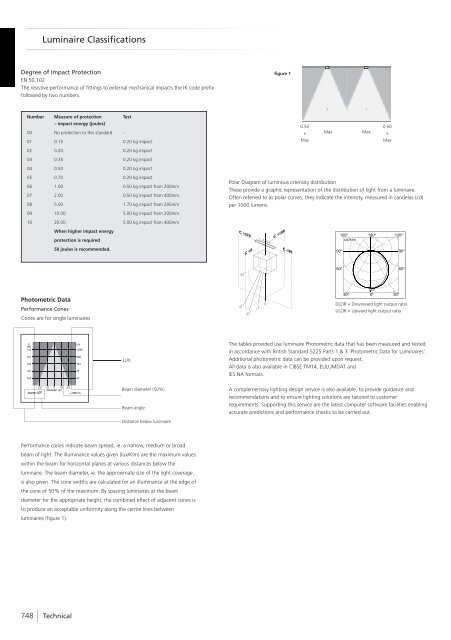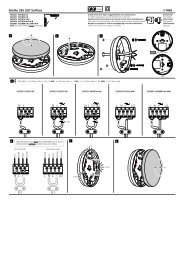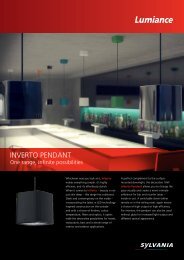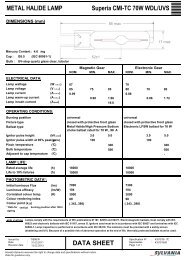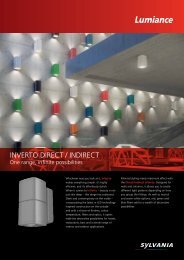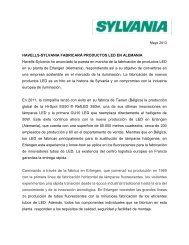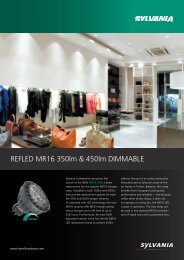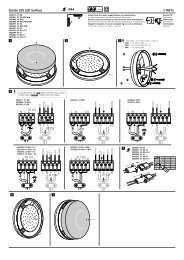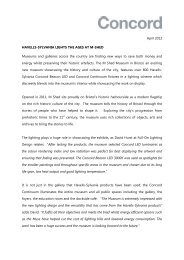- Page 1:
ARCHITECTURAL LIGHTING LUMINAIRES 2
- Page 4 and 5:
Contents Recessed Modular Pages 9 -
- Page 6 and 7:
Contents Ambient Decorative Pages 4
- Page 8:
Contents Lighting Controls Pages 71
- Page 11 and 12:
Made In Europe Made In Europe Havel
- Page 13 and 14:
Our Brand New Website Havells-Sylva
- Page 15:
Product Specification Guidance for
- Page 19 and 20:
Double width CDP (conical de-glarin
- Page 21 and 22:
Concave Officelyte - Low Profile Of
- Page 23 and 24:
Concave Officelyte 600/625
- Page 25 and 26:
Officelyte LIGHT SOURCE INCLUDE
- Page 29 and 30:
Super efficient LED modular luminai
- Page 33 and 34:
Control Gear: Standard: Integral el
- Page 36:
Mediseal Sealed Fitting LIG
- Page 39 and 40:
LumiPanel Square LumiPanel Round Co
- Page 41:
LumiDriver Accessories Lumidriver L
- Page 44 and 45:
RANA Recessed LIGHT
- Page 46 and 47:
RANA Recessed LIGHT SOURCE INCLUDED
- Page 48:
RANA Pull Up LIGHT SOURCE INCLU
- Page 52 and 53:
Rubico Micro Prismatic Optic (MPO)
- Page 54 and 55:
Rubico Louvre with satin wings Rubi
- Page 56 and 57:
Rubico louvre with perforated wings
- Page 58 and 59:
Sylwing R Bess 4 LIGHT S
- Page 60 and 61:
Sylwing R Asymmetrical LIGHT SOU
- Page 63 and 64:
Control gear: Electronic Dimmable:
- Page 65:
Start Recessed T5 LIGHT SOURCE INCL
- Page 68 and 69:
Ivy 2 - Bright louvre
- Page 71 and 72:
Control gear: Emergency: Diffuser:
- Page 73 and 74:
Start Recessed T8 Mirror bright 600
- Page 75 and 76:
Sylseal 65 / 54
- Page 80:
73 Mini Continuum LED 79 Continuum
- Page 83 and 84:
Mini Continuum LED - Trimless
- Page 85:
Mini Continuum Extension Modules LI
- Page 89 and 90:
Continuum Extrusions & Battens
- Page 92 and 93:
Control Gear: Standard: integral el
- Page 94 and 95:
Quadrille T16 Module with High Effi
- Page 96 and 97:
Quadrille T16 Modules Indirect Modu
- Page 98 and 99:
Quadrille Connectors Accessories Qu
- Page 102 and 103:
Control Gear: Standard: integral el
- Page 104 and 105:
Ovation 65 Module - High Efficiency
- Page 106 and 107:
Ovation 65 T16 Modules LI
- Page 108 and 109:
Ovation 65 Connectors Accessories X
- Page 110:
Ovation 65 Suspensions Accessories
- Page 113 and 114:
RANA Direct / Indirect & Direct
- Page 115 and 116:
RANA Direct / Indirect & Direct LIG
- Page 117 and 118:
RANA Direct / Indirect & Direct LIG
- Page 119 and 120:
RANA Direct / Indirect & Direct LIG
- Page 122 and 123:
Control gear: Dimmable: Sensor: Eme
- Page 124 and 125:
DeltaWing 1-lamp version 2-lamp ver
- Page 127:
StartWing low profile luminaire
- Page 130 and 131:
Sylwing Bess 4 Surface Mounted
- Page 132 and 133:
Sylwing Connections and Through Wir
- Page 134:
Sylwing Accessories Accessories T C
- Page 137 and 138:
Start Sylmaster T8 L
- Page 139 and 140:
Sylmaster T5 PL Louvre
- Page 141 and 142:
Sylmaster T8 Double Optic Satin
- Page 143 and 144:
Sylmaster T8 HR Louvre
- Page 145 and 146:
Sylmaster T8 White Louvre
- Page 147 and 148:
Sylmaster Accessories Accessories I
- Page 149 and 150:
Syl-Louver Visual 60
- Page 151 and 152:
Syl-Louver Double Optic Satin Brigh
- Page 153 and 154:
Syl-Louver HR Louvre Direct / Indir
- Page 155 and 156:
Syl-Louver White Louvre LIGHT
- Page 157 and 158:
Syl-Louver Structures Accessories I
- Page 160:
153 Beacon Projector 159 Beacon Mus
- Page 163 and 164:
Beacon Projector - Iris
- Page 165:
Beacon Projector - Gobo
- Page 169 and 170:
Beacon Muse 13W LIGHT S
- Page 171:
Beacon Muse - DALI Dimming 13W & 26
- Page 175 and 176:
Beacon LED 13W - Spot
- Page 177 and 178:
Beacon LED Accent Spot/Flood - 13W
- Page 179 and 180:
Beacon LED High Output Flood-26W
- Page 181 and 182:
Beacon High Output CMI/CDM-T Spot
- Page 183 and 184:
Beacon CMI/CDM-T 35 & 70W Spot
- Page 185:
Beacon CMI/CDM-T 35/70W Accessories
- Page 188 and 189:
Beacon CMI-Tmini/Flood
- Page 190 and 191:
Beacon Low Energy 26/32/42W TC-TEL
- Page 192 and 193:
Beacon CMI-Tmini/CMH-Supermini & Lo
- Page 194 and 195:
Beacon BriteSpot ES50 Metal Halide
- Page 198 and 199:
° LyteLab 189
- Page 202 and 203:
Stadium II Spotlights 193 SPOTLIGHT
- Page 204 and 205:
Stadium II Pro - Leading and Traili
- Page 206:
196 Spotlights
- Page 209 and 210:
Lyteframe Suspended - Reflector Ser
- Page 212 and 213:
Control Gear: Adjustment Angles: Ho
- Page 214 and 215:
Axo XL
- Page 216:
Axo Display
- Page 219 and 220:
Giro Small LIGHT SO
- Page 221 and 222:
Pixo Pro XL & XS LIGHT SOURCE I
- Page 223:
Punto HIT-DE/CMI-TD Track LIG
- Page 228 and 229:
Construction: Total Max Load: Finis
- Page 230 and 231:
Lytespan 1 Single Circuit Track Sys
- Page 232 and 233:
Lytespan LP Single Circuit Track Sy
- Page 234:
Lytespan LP Single Circuit Track Sy
- Page 237 and 238:
Three Circuit Track System Planning
- Page 239 and 240:
Lytespan 3 Three Circuit Track Syst
- Page 241 and 242:
Lytespan 3 Three Circuit & DALI Tra
- Page 243 and 244:
Lytebeam Three Circuit (Direct & In
- Page 246 and 247:
Universal Suspension Single, Three
- Page 248 and 249:
Universal Suspensions Single & Thre
- Page 250 and 251:
Lytebeam LED Emergency
- Page 252 and 253:
Microtrack 3 Three circuit track sy
- Page 254:
Nanotrack 1 Single circuit track sy
- Page 258 and 259:
Concord was the original designer a
- Page 260 and 261:
Ascent 150 - Very High Output
- Page 262 and 263:
Ascent 150 - Black Reflector
- Page 264:
Ascent 150 Accessories Accessories
- Page 267 and 268:
LED 150-TE II 160mm Ø Bezel
- Page 269 and 270:
LED 150-TE II 160mm Ø Accessories
- Page 271 and 272:
LED 150-TE II 185mm Ø Bezel
- Page 273 and 274:
LED 150-TE II 185mm Ø Accessories
- Page 275 and 276:
LED 150-TE II 215mm Ø Bezel
- Page 277:
LED 150-TE II 215mm Ø Accessories
- Page 281 and 282:
Ascent 50
- Page 284 and 285:
Applications 1. gl
- Page 286 and 287:
LED 100-TE Architectural 160mmØ
- Page 288 and 289:
LED 100-TE Deco 160mmØ
- Page 290:
LED 100-TE Eco 160mmØ
- Page 293:
Kometa 300 Circular
- Page 297 and 298:
Ascent Performance Cones In theory,
- Page 299:
Ascent Performance Cones Wallwasher
- Page 303 and 304:
Equinox IV CMI/CDM-T
- Page 305 and 306:
Equinox IV CMI/CDM-TD
- Page 308 and 309:
The Beacon Recessed Adjustable spot
- Page 310 and 311:
BRA LED Spot/Flood - 26W L
- Page 312 and 313:
BRA (Beacon Recessed Adjustable) CM
- Page 314:
BRA (Beacon Recessed Adjustable) CM
- Page 317 and 318:
RouteLED - Standard emergenc
- Page 319:
RouteLED - Corridor emergenc
- Page 323 and 324:
Insaver LED 75 LIGHT SOUR
- Page 325 and 326:
Insaver LED 150 - High Output
- Page 327:
Insaver LED Accessories Accessories
- Page 331 and 332:
Insaver TC-T 175
- Page 333 and 334:
Insaver TC-T 250
- Page 335 and 336:
Insaver HE 175 Open
- Page 337 and 338:
Insaver HE 225 Wallwasher & Surface
- Page 339 and 340:
Insaver HE 225 Cone
- Page 341 and 342:
Insaver HE 225 Topper
- Page 343 and 344:
Insaver Classic 150/180 Topper L
- Page 346 and 347:
Control Gear: Dimmable: Emergency:
- Page 348:
Insaver Quadretto HIT
- Page 351 and 352:
Syl-Lighter LED - Round
- Page 353:
Syl-Lighter CFL
- Page 358 and 359:
Myriad V next generation defines in
- Page 360 and 361:
Myriad V LED 30º IP65 Glass Chrome
- Page 362 and 363:
Myriad V 50 Downlight
- Page 364 and 365:
Myriad V Compact Downlight
- Page 366 and 367:
Myriad V 20W/35W CMI-Tmini Downligh
- Page 368:
Myriad V Myriad 50 Emergency Three
- Page 371 and 372:
Lyteframe Recessed - Reflector Seri
- Page 374 and 375:
Adjustment: Finish: 45º tilt and 3
- Page 378 and 379:
Control gear: Electronic Dimmable:
- Page 380 and 381:
Signo 155 Capsule
- Page 382:
Signo Fixed
- Page 385:
Punto Recessed
- Page 389 and 390:
Motto 82 & Motto Trend 82 LIGHT
- Page 391 and 392:
Motto 110
- Page 393:
Motto 144 Modular
- Page 397:
Motto Trend LED LIGHT SOURCE IN
- Page 401 and 402:
Inset Trend 75 Swing IP44 Indoor, O
- Page 403 and 404:
Inset Trend 62 Flush
- Page 405 and 406:
Inset Pro 80/90 Comfort
- Page 408 and 409:
Control gear: Electronic Dimmable:
- Page 410 and 411:
Instar Comfort LED LIGHT SO
- Page 412 and 413:
Instar Trend 75 Swing IP44 Indoor &
- Page 414 and 415:
Instar Trend 62 Flush
- Page 416 and 417:
Instar Pro 80/95 Swing & 80 Comfort
- Page 418 and 419:
Instar Classic 70/90 Cone/Standard
- Page 420:
Instar Classic 90/105 Halogen
- Page 423 and 424:
86 Sylfire Compact Fixed Fire Rated
- Page 425 and 426:
105 Sylfire Compact IP65 Fire Rated
- Page 427 and 428:
105 Sylfire LED Fire Rated Downligh
- Page 429 and 430:
Sylfire Tilt Twist & Lock Fire Rate
- Page 431 and 432:
Sylfire CFL Twist & Lock Fire Rated
- Page 433 and 434:
Sylfire LED Tilt Twist & Lock Fire
- Page 435 and 436:
Sylfire Fixed Big Can Twist & Lock
- Page 437:
Sylfire IP65 Big Can Twist & Lock F
- Page 441 and 442:
Intro Mains Voltage Downlight IP23
- Page 443:
Intro Low Voltage Downlight IP65
- Page 447 and 448:
Lido Low Voltage Downlight IP65
- Page 449 and 450:
Lumidriver Accessories Lumidriver L
- Page 451 and 452:
Lumipower Gear
- Page 454:
447 Myriad 451 Cassini 455 InVerto
- Page 457 and 458:
Myriad V Solid State Pendant
- Page 460 and 461:
Control Gear: Emergency: Diffuser:
- Page 464 and 465:
Control gear: Electronic Dimmable:
- Page 466:
InVerto Pendant 102 102 52 32 179 1
- Page 469:
Bako - Large for Superia CMI-T
- Page 473:
Matrix Pendant LIGHT SOURC
- Page 476 and 477:
Pento XL 370
- Page 478 and 479:
Pento XS Deco 185 LIGHT
- Page 482:
475 Glace 479 Cassini 485 Brio 489
- Page 485:
Glace
- Page 489 and 490:
Cassini Planar LED
- Page 491 and 492:
Cassini Radius LED
- Page 494 and 495:
Control Gear: Integral electronic g
- Page 498 and 499:
Control Gear: Emergency: Diffuser:
- Page 500 and 501:
Opaline 450mmØ
- Page 502:
Antiligature Opaline 390mmØ, 490mm
- Page 505 and 506:
Giotto LED 335
- Page 507 and 508:
Giotto LED 235
- Page 509:
Giotto LED 200 & LED 200 Numberligh
- Page 513 and 514:
Giotto 335 LIGHT SOUR
- Page 515 and 516:
Giotto 235 & 235 A
- Page 517 and 518:
Giotto 235 Oval deco
- Page 519:
Fresco 300 & 400 INCLUDED
- Page 522 and 523:
LumiPanel Square LumiPanel Round Co
- Page 526 and 527:
Control Gear: Electronic
- Page 529 and 530:
LumiFix LED Kit
- Page 532 and 533:
Control Gear: Electronic Dimmable:
- Page 534 and 535:
InVerto Direct Dimensions (mm) 110
- Page 536 and 537:
InVerto Surface mounted Dimensions
- Page 538:
InVerto Direct/Indirect Dimensions
- Page 541:
Bako
- Page 544 and 545:
Insaver Micro-Lynx F
- Page 546 and 547:
Plani Lux LIGHT
- Page 548 and 549:
Elan Shaverlight
- Page 550 and 551:
Swift Shaverlight LIGHT SOURCE
- Page 552 and 553:
LS100 / LS110 T5 Cabinet Lite
- Page 554:
LS400 T8 Super Lite
- Page 557 and 558:
Weatherproof
- Page 559 and 560:
Weatherproof General Information PC
- Page 561 and 562:
Sylproof Superia LED LIGHT
- Page 563 and 564:
Sylproof Superia Polycarbonate Sylp
- Page 565 and 566:
Sylproof Accessories Accessories Th
- Page 567 and 568:
Hydroproof 2
- Page 569 and 570:
Hydroproof 2 Accessories Accessorie
- Page 571 and 572:
Sylfog
- Page 573 and 574:
Sylfog Tubular
- Page 575:
PST LIGHT SOURCE INCLUDED
- Page 580 and 581:
Control Gear: Dimmable: Housing: Fi
- Page 582 and 583:
Fast Trunking System LIGHT SOURCE I
- Page 584:
Fast Trunking System Accessories Ac
- Page 587 and 588:
Sylfast LIGHT SOURCE NOT INCLUDE
- Page 589 and 590:
Sylfast SSE-T8 LIGHT SOURCE NO
- Page 591 and 592:
Sylfast 2
- Page 593 and 594:
Sylref-E White Painted Reflector
- Page 595 and 596:
SBH-O
- Page 597 and 598:
Alioth LIG
- Page 599 and 600:
Iliah
- Page 601:
Sportsbay LIGHT SOURCE IN
- Page 605 and 606:
SYL Safe This guide should be read
- Page 607:
SYL Safe
- Page 612 and 613:
Control Gear: Magnetic Housing: Die
- Page 614 and 615:
Archflood 1 Accessories Accessories
- Page 616 and 617:
Archflood 2 Accessories Accessories
- Page 618 and 619:
Archflood GC2 Standard Floodlight v
- Page 620 and 621:
Archflood 3 Accessories Accessories
- Page 622:
Archflood GC3 Standard Floodlight v
- Page 625 and 626:
Powerflood 1
- Page 628 and 629:
Control Gear: Housing: Finish: Prot
- Page 630 and 631:
FloodLED 48
- Page 632:
FloodLED 12
- Page 635 and 636:
Sylveo 1
- Page 637 and 638:
Sylveo 2
- Page 639 and 640:
Sylflood LIGHT SOURCE INCLUDED
- Page 641 and 642:
FMD 1,000W / 2,000W Circular LIGHT
- Page 643 and 644:
AL 300 LIGHT SOURCE NOT INCLUDED
- Page 646:
640 Floodline 1 642 Floodline 2 644
- Page 649 and 650:
Floodline 1
- Page 651 and 652:
Floodline 2
- Page 653 and 654:
Floodline 3
- Page 655 and 656:
Floodline 4 For all units:
- Page 658:
652 Inground 218 654 Inground 314 6
- Page 661 and 662:
Inground 218
- Page 663 and 664:
Inground 314
- Page 665 and 666:
Inground CT420
- Page 668:
669 Brio 674 Sterling 678 Monitor 6
- Page 671 and 672:
Brio IP65 LED
- Page 673 and 674:
Brio IP65 LIGHT
- Page 675 and 676:
Sterling Bulkhead - LED
- Page 677:
Sterling Asymmetric Bulkhead
- Page 680:
Monitor
- Page 683 and 684:
InVerto Direct/Indirect i
- Page 685 and 686:
InVerto Direct luminaire
- Page 687 and 688:
InVerto Surface mounted mo
- Page 690 and 691:
Control Gear: Housing: Finish: Prot
- Page 692 and 693:
Onwall 2
- Page 694 and 695:
Onwall 4
- Page 697 and 698: Guide Bulkhead - Round LIGHT S
- Page 700: 702 Inwall 1 703 Inwall 2 704 Inwal
- Page 703 and 704: Inwall 1
- Page 705 and 706: Inwall 3
- Page 707 and 708: Inwall 5
- Page 710: 711 Skyline Pole Top POLE TOP 709 P
- Page 713: Skyline Pole Top
- Page 717 and 718: Energy Efficient Lighting Controls
- Page 719 and 720: Lighting Control Wiring diagrams DS
- Page 721 and 722: Lighting Control - Control Boxes LC
- Page 723 and 724: Colour - Changing Lighting Controls
- Page 725 and 726: Power Supply Module 0041613 MAINS I
- Page 727 and 728: PIR detectors - Ceiling-mounted Fea
- Page 729 and 730: Microwave detectors - Wall-mounted
- Page 731 and 732: Microwave detectors - Wall-mounted
- Page 733 and 734: Microwave detectors - Ceiling-mount
- Page 735 and 736: Microwave detectors - Ceiling-mount
- Page 737 and 738: Microwave detectors - Ceiling-mount
- Page 739 and 740: Microwave detectors - Ceiling-mount
- Page 741 and 742: Microwave detectors - Ceiling-mount
- Page 743 and 744: Technical information Ballast lumen
- Page 745 and 746: Technical information Performance c
- Page 747: Emergency Lighting Emergency lighti
- Page 751 and 752: Guide To Symbols Electrical protect
- Page 753 and 754: Lamp Information for luminaires Low
- Page 755 and 756: Lamp Information for luminaires T5
- Page 757 and 758: Lamp Information for luminaires HID
- Page 759 and 760: Lamp Information for luminaires HID
- Page 761 and 762: Calculation Data Total Lamp Lumen /
- Page 763 and 764: Specifications The following notes
- Page 765 and 766: Standard Terms And Conditions Of Sa
- Page 767 and 768: Standard Terms And Conditions Of Sa
- Page 769 and 770: Index Item Code Page Number Item Co
- Page 771 and 772: Index Item Code Page Number Item Co
- Page 773 and 774: Index Item Code Page Number Item Co
- Page 775 and 776: Index Item Code Page Number Item Co
- Page 777 and 778: Index Item Code Page Number Item Co
- Page 779 and 780: Index Item Code Page Number Item Co
- Page 781 and 782: Index Item Code Page Number Item Co
- Page 783 and 784: Notes 782 Technical
- Page 785 and 786: Notes 784 Technical
- Page 787 and 788: Notes 786 Technical
- Page 789 and 790: Notes 788 Technical
- Page 791 and 792: Notes 790 Technical
- Page 793 and 794: Notes 792 Technical
- Page 795: Notes 794 Technical


